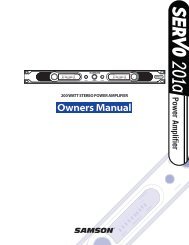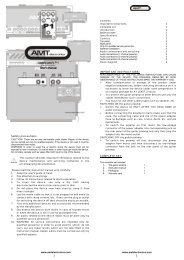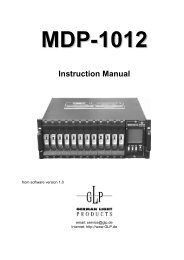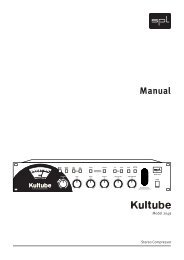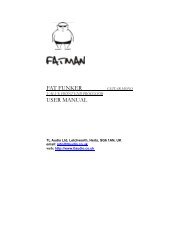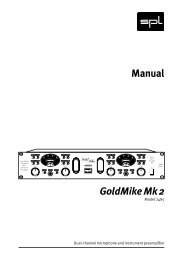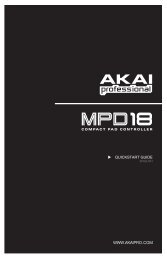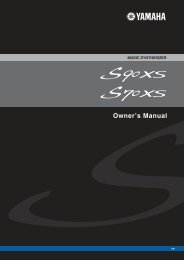Create successful ePaper yourself
Turn your PDF publications into a flip-book with our unique Google optimized e-Paper software.
ABOUT POLYPHONY<br />
Optimising Your Patches<br />
If you find your patch is making use of any of the above features, try alternatives to reduce the CPU load.<br />
Remember that a feature is active and consuming calculation power even when set to a very small value, so<br />
in certain cases it can be wise to switch something off rather than have something which is barely audible<br />
but still using up resources. For instance, if Osc Balance is set to -63, you will almost certainly be unable to<br />
hear Oscillator 2, so try turning it to -64, at which point Oscillator 2 will be switched off altogether, thereby<br />
freeing up resources. If an effect’s Mix or Send parameter is set to Off or Dry, then it will not use any resources,<br />
so again, if a patch is using only tiny amounts of a particular effect, then it may be advisable to switch it<br />
off entirely.<br />
The <strong>Virus</strong> also has to work a little harder when both filters are used. If you only need a gentle, 2-pole filter<br />
for a particular sound, then by turning Filter Balance fully left (-64) you switch off Filter 2, thereby freeing up<br />
some voices.<br />
Another factor that can be easily overlooked is the length of release tails. These can cause the voice count<br />
to stack up much more quickly than you may think, and in an arrangement you can often reduce them a certain<br />
amount without having a detrimental effect to the overall mix. Please check the Priority parameter (Multi<br />
Menu), which you can use to prioritise certain Parts against note-stealing. In other words, setting the most<br />
crucial Parts to Priority = High will push those Parts remaining on Priority = Low to the front of the queue<br />
when the <strong>Virus</strong> needs to steal voices.<br />
Try not to use the mod matrix to apply an effect than be achieved by using one of the hardwired slots - e.g. if<br />
you want LFO to modulate Cutoff 1, use the LFO2>Cutoff1 parameter, which is always on anyway; by using<br />
the mod matrix instead, you will be using unnecessary additional resources.<br />
Some controller sources you may choose to apply in the mod matrix take more calculation power than others<br />
- this is because some have to be calculated per-voice, whereas some are only applied globally. For<br />
instance, the modwheel applies to all voices on a given part simulaneously, thereby only needing one calculation<br />
per change of position, whereas KeyFollow or Filter Envelope apply to each individual voice, which can<br />
result in an increase in calculation power. If you are playing a polyphonic patch, this can make quite a difference,<br />
especially if you are using several mod routings of this kind at the same time.<br />
It is also advisable to switch off any redundant mod slots, i.e. don’t just turn them down to zero, switch the<br />
source and/or destination parameters to Off.<br />
Finally, remember that every single feature you can turn on and off can have an effect on the polyphony, even<br />
if it’s only by a single voice, but sometimes you may only need to find yourself that one extra voice to achieve<br />
the result you desire, so think efficient!



